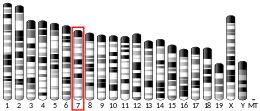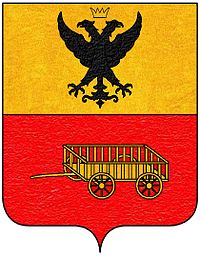APBB1
APBB1| APBB1 | |||||||||||||||||||||||||
|---|---|---|---|---|---|---|---|---|---|---|---|---|---|---|---|---|---|---|---|---|---|---|---|---|---|
 | |||||||||||||||||||||||||
| |||||||||||||||||||||||||
| 식별자 | |||||||||||||||||||||||||
| 별칭 | APBB1, 아밀로이드 베타(A4) 전구 단백질 결합, 패밀리 B, 멤버 1(Fe65), FE65, MGC:9072, RIR, 아밀로이드 베타 전구 단백질 결합 패밀리 B 멤버 1 | ||||||||||||||||||||||||
| 외부 ID | OMIM: 602709 MGI: 107765 호몰로진: 898 GeneCard: APBB1 | ||||||||||||||||||||||||
| |||||||||||||||||||||||||
| |||||||||||||||||||||||||
| |||||||||||||||||||||||||
| |||||||||||||||||||||||||
| 직교체 | |||||||||||||||||||||||||
| 종 | 인간 | 마우스 | |||||||||||||||||||||||
| 엔트레스 | |||||||||||||||||||||||||
| 앙상블 | |||||||||||||||||||||||||
| 유니프로트 | |||||||||||||||||||||||||
| RefSeq(mRNA) |
| ||||||||||||||||||||||||
| RefSeq(단백질) |
| ||||||||||||||||||||||||
| 위치(UCSC) | Chr 11: 6.4 – 6.42Mb | Chr 7: 105.21 – 105.23Mb | |||||||||||||||||||||||
| PubMed 검색 | [3] | [4] | |||||||||||||||||||||||
| 위키다타 | |||||||||||||||||||||||||
| |||||||||||||||||||||||||
아밀로이드 베타 A4 전구체 단백질 결합 가족 B 멤버 1은 인간에서 APBB1 유전자에 의해 인코딩되는 단백질이다.[5][6][7]
함수
이 유전자에 의해 암호화된 단백질은 Fe65 단백질 계열의 일원이다.그것은 핵에 국부화된 어댑터 단백질이다.알츠하이머병 아밀로이드 전구단백질(APP), 전사인자 CP2/LSF/LBP1 및 저밀도 지단백질 수용체 관련 단백질과 상호작용한다.APP는 유전자 제품의 핵 변환을 막을 수 있는 세포질 앵커링 사이트로 기능한다.이 암호화된 단백질은 알츠하이머병의 병원체 생성에 중요한 역할을 할 수 있다.그것은 필사하는 것을 규제하는 것으로 생각된다.또한 티미딜레이트 싱타아제 식을 하향 조절하여 세포 주기 진행을 차단하는 것이 관찰된다.이 유전자에 대해 여러 가지 대안으로 분할된 대본 변형이 설명되었지만 전체 길이 순서의 일부는 알려져 있지 않다.[7]
상호작용
APBB1은 APLP2, [8][9]TFP2, [10]LRP1[11], Amyloid 전구 단백질과 상호작용하는 것으로 나타났다.[8][9][11][12][13]
참조
- ^ a b c GRCh38: 앙상블 릴리스 89: ENSG00000166313 - 앙상블, 2017년 5월
- ^ a b c GRCm38: 앙상블 릴리스 89: ENSMUSG000037032 - 앙상블, 2017년 5월
- ^ "Human PubMed Reference:". National Center for Biotechnology Information, U.S. National Library of Medicine.
- ^ "Mouse PubMed Reference:". National Center for Biotechnology Information, U.S. National Library of Medicine.
- ^ McLoughlin DM, Miller CC (Jan 1997). "The intracellular cytoplasmic domain of the Alzheimer's disease amyloid precursor protein interacts with phosphotyrosine-binding domain proteins in the yeast two-hybrid system". FEBS Lett. 397 (2–3): 197–200. doi:10.1016/S0014-5793(96)01128-3. PMID 8955346.
- ^ Bressler SL, Gray MD, Sopher BL, Hu Q, Hearn MG, Pham DG, Dinulos MB, Fukuchi K, Sisodia SS, Miller MA, Disteche CM, Martin GM (Feb 1997). "cDNA cloning and chromosome mapping of the human Fe65 gene: interaction of the conserved cytoplasmic domains of the human beta-amyloid precursor protein and its homologues with the mouse Fe65 protein". Hum Mol Genet. 5 (10): 1589–98. doi:10.1093/hmg/5.10.1589. PMID 8894693.
- ^ a b "Entrez Gene: APBB1 amyloid beta (A4) precursor protein-binding, family B, member 1 (Fe65)".
- ^ a b Guénette SY, Chen J, Jondro PD, Tanzi RE (Oct 1996). "Association of a novel human FE65-like protein with the cytoplasmic domain of the beta-amyloid precursor protein". Proceedings of the National Academy of Sciences of the United States of America. 93 (20): 10832–7. Bibcode:1996PNAS...9310832G. doi:10.1073/pnas.93.20.10832. PMC 38241. PMID 8855266.
- ^ a b Tanahashi H, Tabira T (Feb 1999). "Molecular cloning of human Fe65L2 and its interaction with the Alzheimer's beta-amyloid precursor protein". Neurosci. Lett. 261 (3): 143–6. doi:10.1016/S0304-3940(98)00995-1. PMID 10081969. S2CID 54307954.
- ^ Zambrano N, Minopoli G, de Candia P, Russo T (Aug 1998). "The Fe65 adaptor protein interacts through its PID1 domain with the transcription factor CP2/LSF/LBP1". J. Biol. Chem. 273 (32): 20128–33. doi:10.1074/jbc.273.32.20128. PMID 9685356.
- ^ a b Trommsdorff M, Borg JP, Margolis B, Herz J (Dec 1998). "Interaction of cytosolic adaptor proteins with neuronal apolipoprotein E receptors and the amyloid precursor protein". J. Biol. Chem. 273 (50): 33556–60. doi:10.1074/jbc.273.50.33556. PMID 9837937.
- ^ Borg JP, Ooi J, Levy E, Margolis B (Nov 1996). "The phosphotyrosine interaction domains of X11 and FE65 bind to distinct sites on the YENPTY motif of amyloid precursor protein". Mol. Cell. Biol. 16 (11): 6229–41. doi:10.1128/mcb.16.11.6229. PMC 231626. PMID 8887653.
- ^ Zambrano N, Buxbaum JD, Minopoli G, Fiore F, De Candia P, De Renzis S, Faraonio R, Sabo S, Cheetham J, Sudol M, Russo T (Mar 1997). "Interaction of the phosphotyrosine interaction/phosphotyrosine binding-related domains of Fe65 with wild-type and mutant Alzheimer's beta-amyloid precursor proteins". J. Biol. Chem. 272 (10): 6399–405. doi:10.1074/jbc.272.10.6399. PMID 9045663.
외부 링크
- UCSC 게놈 브라우저의 인간 APBB1 게놈 위치 및 APBB1 유전자 세부 정보 페이지.
추가 읽기
- Russo T, Faraonio R, Minopoli G, De Candia P, De Renzis S, Zambrano N (1998). "Fe65 and the protein network centered around the cytosolic domain of the Alzheimer's beta-amyloid precursor protein". FEBS Lett. 434 (1–2): 1–7. doi:10.1016/S0014-5793(98)00941-7. PMID 9738440. S2CID 24288811.
- Askanas V, Engel WK (2004). "Proposed pathogenetic cascade of inclusion-body myositis: importance of amyloid-beta, misfolded proteins, predisposing genes, and aging". Current Opinion in Rheumatology. 15 (6): 737–44. doi:10.1097/00002281-200311000-00009. PMID 14569203. S2CID 23763978.
- Borg JP, Ooi J, Levy E, Margolis B (1996). "The phosphotyrosine interaction domains of X11 and FE65 bind to distinct sites on the YENPTY motif of amyloid precursor protein". Mol. Cell. Biol. 16 (11): 6229–41. doi:10.1128/mcb.16.11.6229. PMC 231626. PMID 8887653.
- Zambrano N, Buxbaum JD, Minopoli G, Fiore F, De Candia P, De Renzis S, Faraonio R, Sabo S, Cheetham J, Sudol M, Russo T (1997). "Interaction of the phosphotyrosine interaction/phosphotyrosine binding-related domains of Fe65 with wild-type and mutant Alzheimer's beta-amyloid precursor proteins". J. Biol. Chem. 272 (10): 6399–405. doi:10.1074/jbc.272.10.6399. PMID 9045663.
- Ermekova KS, Zambrano N, Linn H, Minopoli G, Gertler F, Russo T, Sudol M (1998). "The WW domain of neural protein FE65 interacts with proline-rich motifs in Mena, the mammalian homolog of Drosophila enabled". J. Biol. Chem. 272 (52): 32869–77. doi:10.1074/jbc.272.52.32869. PMID 9407065.
- Duilio A, Faraonio R, Minopoli G, Zambrano N, Russo T (1998). "Fe65L2: a new member of the Fe65 protein family interacting with the intracellular domain of the Alzheimer's beta-amyloid precursor protein". Biochem. J. 330 (Pt 1): 513–9. doi:10.1042/bj3300513. PMC 1219167. PMID 9461550.
- Blanco G, Irving NG, Brown SD, Miller CC, McLoughlin DM (1998). "Mapping of the human and murine X11-like genes (APBA2 and apba2), the murine Fe65 gene (Apbb1), and the human Fe65-like gene (APBB2): genes encoding phosphotyrosine-binding domain proteins that interact with the Alzheimer's disease amyloid precursor protein". Mamm. Genome. 9 (6): 473–5. doi:10.1007/s003359900800. PMID 9585438. S2CID 31066473.
- Zambrano N, Minopoli G, de Candia P, Russo T (1998). "The Fe65 adaptor protein interacts through its PID1 domain with the transcription factor CP2/LSF/LBP1". J. Biol. Chem. 273 (32): 20128–33. doi:10.1074/jbc.273.32.20128. PMID 9685356.
- Hu Q, Kukull WA, Bressler SL, Gray MD, Cam JA, Larson EB, Martin GM, Deeb SS (1998). "The human FE65 gene: genomic structure and an intronic biallelic polymorphism associated with sporadic dementia of the Alzheimer type". Hum. Genet. 103 (3): 295–303. doi:10.1007/s004390050820. PMID 9799084. S2CID 22957756.
- Trommsdorff M, Borg JP, Margolis B, Herz J (1999). "Interaction of cytosolic adaptor proteins with neuronal apolipoprotein E receptors and the amyloid precursor protein". J. Biol. Chem. 273 (50): 33556–60. doi:10.1074/jbc.273.50.33556. PMID 9837937.
- Sabo SL, Lanier LM, Ikin AF, Khorkova O, Sahasrabudhe S, Greengard P, Buxbaum JD (1999). "Regulation of beta-amyloid secretion by FE65, an amyloid protein precursor-binding protein". J. Biol. Chem. 274 (12): 7952–7. doi:10.1074/jbc.274.12.7952. PMID 10075692.
- Hu Q, Hearn MG, Jin LW, Bressler SL, Martin GM (2000). "Alternatively spliced isoforms of FE65 serve as neuron-specific and non-neuronal markers". J. Neurosci. Res. 58 (5): 632–40. doi:10.1002/(SICI)1097-4547(19991201)58:5<632::AID-JNR4>3.0.CO;2-P. PMID 10561691.
- Lambrechts A, Kwiatkowski AV, Lanier LM, Bear JE, Vandekerckhove J, Ampe C, Gertler FB (2000). "cAMP-dependent protein kinase phosphorylation of EVL, a Mena/VASP relative, regulates its interaction with actin and SH3 domains". J. Biol. Chem. 275 (46): 36143–51. doi:10.1074/jbc.M006274200. PMID 10945997.
- Minopoli G, de Candia P, Bonetti A, Faraonio R, Zambrano N, Russo T (2001). "The beta-amyloid precursor protein functions as a cytosolic anchoring site that prevents Fe65 nuclear translocation". J. Biol. Chem. 276 (9): 6545–50. doi:10.1074/jbc.M007340200. PMID 11085987.
- Lau KF, McLoughlin DM, Standen CL, Irving NG, Miller CC (2001). "Fe65 and X11beta co-localize with and compete for binding to the amyloid precursor protein". NeuroReport. 11 (16): 3607–10. doi:10.1097/00001756-200011090-00041. PMID 11095528.
- McLoughlin DM, Standen CL, Lau KF, Ackerley S, Bartnikas TP, Gitlin JD, Miller CC (2001). "The neuronal adaptor protein X11alpha interacts with the copper chaperone for SOD1 and regulates SOD1 activity". J. Biol. Chem. 276 (12): 9303–7. doi:10.1074/jbc.M010023200. PMID 11115513.
- Zambrano N, Bruni P, Minopoli G, Mosca R, Molino D, Russo C, Schettini G, Sudol M, Russo T (2001). "The beta-amyloid precursor protein APP is tyrosine-phosphorylated in cells expressing a constitutively active form of the Abl protoncogene". J. Biol. Chem. 276 (23): 19787–92. doi:10.1074/jbc.M100792200. PMID 11279131.








